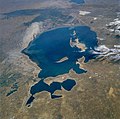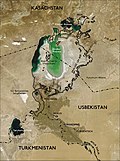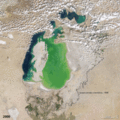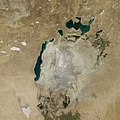Aral Sea
The Aral Sea (Kazakh: [Арал теңізі] Error: {{Lang}}: text has italic markup (help) (Aral tengizi), Uzbek: Orol dengizi, Russian: Аральскοе мοре) was a lake in Central Asia. It is between Kazakhstan in the north and Karakalpakstan, an autonomous region of Uzbekistan, in the south.
| Aral Sea | |
|---|---|
| Location | Kazakhstan - Uzbekistan, Central Asia |
| Coordinates | 45°N 60°E / 45°N 60°ECoordinates: 45°N 60°E / 45°N 60°E |
| Lake type | endorheic, natural lake, reservoir (North) |
| Primary inflows | North: Syr Darya South: groundwater only (previously the Amu Darya) |
| Catchment area | 1,549,000 km2 (598,100 sq mi) |
| Basin countries | Afghanistan, Kazakhstan, Tajikistan, Turkmenistan, Uzbekistan |
| Surface area | 17,160 km2 (6,626 sq mi) (2004, four lakes) 28,687 km2 (11,076 sq mi) (1998, two lakes) 68,000 km2 (26,300 sq mi) (1960, one lake) North: 3,300 km2 (1,270 sq mi) (2008) South: 3,500 km2 (1,350 sq mi) (2005) |
| Average depth | North: 8.7 m (29 ft) (2007) South: 14–15 m (46–49 ft)(2005) |
| Max. depth | North: 42 m (138 ft) (2008)[1] 18 m (59 ft) (2007) 30 m (98 ft) (2003) South: 37–40 m (121–131 ft) (2005) 102 m (335 ft) (1989) |
| Water volume | North: 27 km3 (6 cu mi) (2007) |
| Surface elevation | North: 42 m (138 ft) (2007) South: 29 m (95 ft) (2007) 53.4 m (175 ft) (1960)[2] |
Since the 1960s, the Aral Sea shrank. 90% of the sea has gone.[3] The rivers that fed it (the Amu Darya and the Syr Darya) were used by the Soviet Union for irrigating cotton production. What is left of the Aral Sea is heavily polluted, largely as the result of weapons testing, industrial projects, and fertilizer runoff before and after the breakup of the Soviet Union.[3]
There is a project to save at least the northern part of the Aral Sea. For this, a dam was built in the 1990 to stop water running off. Climate improved in the following years, and water levels rose again. However, that dam broke, and was rebuilt in 2005, with international funding.[4]
Another problem was that Rebirth Island had been used for the testing of biological weapons until 1993. It is currently contaminated with anthrax, the plague, and tularemia. Since 2001, it is no longer an island, but a peninsula.
Gallery
Aral Sea Media
The Syr Darya sturgeon (Pseudoscaphirhynchus fedtschenkoi) was a primitive species of fish possibly driven to extinction by the shrinkage of the Aral Sea.
The Ukrainian stickleback (Pungitius platygaster) was the only native species of the Aral Sea to survive its reduction and salinization.
The European flounder (Platichthys flesus) was a saltwater fish introduced to the Aral Sea.
The black carp (Mylopharyngodon piceus) was a freshwater fish introduced to the Aral Sea.
Zebra mussel (Dreissena polymorpha), a former dominant member of the sea's benthic fauna that has since returned to the North Aral Sea.
Parthenogenic brine shrimp (Artemia parthenogenetica), the dominant crustacean of the South Aral Sea and its fragments.
First Russian boats on the Aral Sea, watercolor by Taras Shevchenko, 1848
Map including the Aral Sea and surrounding region (DMA, 1979)
Satellite images show the changing water levels in the Aral Sea from 2000 to 2018.
References
- ↑ The Kazakh Miracle: Recovery of the North Aral Sea. Environment News Service. 2008-08-01. http://www.ens-newswire.com/ens/aug2008/2008-08-01-01.asp. Retrieved 2010-03-22.
- ↑ JAXA - South Aral Sea shrinking but North Aral Sea expanding
- ↑ 3.0 3.1 Qobil, Rustam 2015. Waiting for the sea. BBC News
- ↑ "Aral Sea Reborn". Al Jazeera. July 21, 2012. Archived from the original on 18 April 2020. Retrieved 11 May 2014.
Other websites
![]() Media related to Aral Sea at Wikimedia Commons
Media related to Aral Sea at Wikimedia Commons























